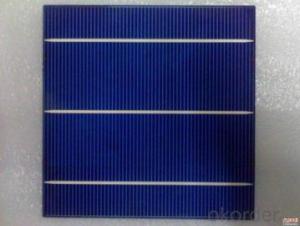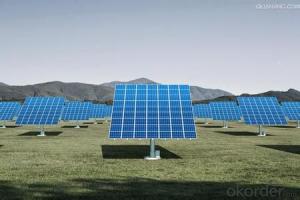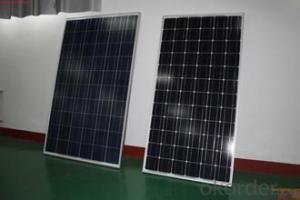Pecvd Poly-Crystalline Silicon Solar Cells
- Loading Port:
- Shanghai
- Payment Terms:
- TT OR LC
- Min Order Qty:
- -
- Supply Capability:
- 5MW pc/month
OKorder Service Pledge
Quality Product, Order Online Tracking, Timely Delivery
OKorder Financial Service
Credit Rating, Credit Services, Credit Purchasing
You Might Also Like
3BB Poly-Crystalline Silicon Solar Cells
futures
• Format: 156 x 156mm ±0.5mm
• Thickness: 210 ± 30μm
• Front (-): 1.4mm bus bars (silver),blue anti-reflecting coating (silicon nitride)
• Back (+): 2.0mm wide soldering pads (silver) back surface field (aluminum)
| No. | Efficiency [ % ] | PMPP [ Wp ] | VMPP [ V ] | IMPP [ A ] | VOC [ V ] | ISC [ A ] | FF [ % ] |
| 12 | 17.90–18.00 | 4.36 | 0.53 | 8.16 | 0.64 | 8.7 | 78.86 |
| 11 | 17.80–17.90 | 4.33 | 0.53 | 8.13 | 0.63 | 8.67 | 78.77 |
| 10 | 17.70–17.80 | 4.31 | 0.53 | 8.11 | 0.63 | 8.64 | 78.69 |
| 9 | 17.60–17.70 | 4.29 | 0.53 | 8.09 | 0.63 | 8.63 | 78.6 |
| 8 | 17.50–17.60 | 4.26 | 0.53 | 8.07 | 0.63 | 8.6 | 78.5 |
| 7 | 17.40–17.50 | 4.24 | 0.53 | 8.05 | 0.63 | 8.59 | 78.41 |
| 6 | 17.30–17.40 | 4.21 | 0.52 | 8.03 | 0.63 | 8.57 | 78.35 |
| 5 | 17.20–17.30 | 4.19 | 0.52 | 8.01 | 0.63 | 8.55 | 78.29 |
| 4 | 17.10–17.20 | 4.16 | 0.52 | 7.99 | 0.62 | 8.53 | 78.23 |
| 3 | 17.00–17.10 | 4.14 | 0.52 | 7.96 | 0.62 | 8.5 | 78.22 |
| 2 | 16.80–17.00 | 4.09 | 0.52 | 7.89 | 0.62 | 8.46 | 77.76 |
| 1 | 16.60–16.80 | 4.04 | 0.52 | 7.83 | 0.62 | 8.45 | 76.78 |
- Q: Can solar cells be used in developing countries?
- Yes, solar cells can be used in developing countries. They offer a sustainable and renewable source of energy that can be harnessed even in remote areas without access to electricity grids. Solar cells can provide clean and affordable electricity, helping to improve living conditions, foster economic growth, and reduce dependence on fossil fuels. Additionally, the decreasing costs and increasing efficiency of solar technology make it an increasingly viable option for developing countries.
- Q: Can solar cells be used to power medical devices or implants?
- Yes, solar cells can be used to power medical devices or implants. They provide a sustainable and renewable source of energy, allowing these devices to operate without the need for frequent battery replacements or external power sources. Additionally, solar cells can be integrated into the design of medical implants, providing a self-sustaining power supply for long-term usage.
- Q: How do solar cells perform in mountainous regions?
- Solar cells can perform well in mountainous regions, especially if they are strategically placed to maximize exposure to sunlight. However, the performance of solar cells can vary depending on the altitude, slope, and orientation of the panels. It is important to consider factors such as shading from nearby peaks or trees, as well as the potential for snow cover during winter months. Overall, with proper planning and installation, solar cells can effectively generate electricity in mountainous regions.
- Q: How do solar cells perform in high altitude environments?
- Solar cells perform well in high altitude environments due to several factors. Firstly, at higher altitudes, there is less atmospheric interference, which means that solar cells receive more direct sunlight and can generate more electricity. Additionally, the colder temperatures at high altitudes can improve the efficiency of solar cells, as they operate more efficiently at lower temperatures. Furthermore, in regions with high altitude, there is often less cloud cover and air pollution, allowing solar cells to receive even more sunlight and operate at maximum capacity. Overall, solar cells are highly suitable for high altitude environments and can provide efficient and reliable renewable energy generation.
- Q: How do solar cells perform in areas with high levels of insect activity?
- Solar cells can still perform well in areas with high levels of insect activity. However, the efficiency of solar cells might be slightly affected if there is a significant accumulation of dust, debris, or insect droppings on the surface of the panels. Regular cleaning and maintenance can help mitigate any potential impact and ensure optimal performance.
- Q: Can solar cells be used for powering data centers?
- Yes, solar cells can be used for powering data centers. Solar energy can be harnessed and converted into electricity through solar cells, which can then be used to power the energy-intensive operations of data centers. This renewable energy source can help reduce the environmental impact of data centers by decreasing their reliance on fossil fuels and mitigating carbon emissions. However, the feasibility of using solar cells for data centers depends on factors such as the availability of sunlight, the size of the data center, and the energy requirements of the facility.
- Q: Can solar cells be installed on curved surfaces?
- Yes, solar cells can be installed on curved surfaces. Flexible solar panels have been developed which allow for installation on various curved surfaces such as vehicles, boats, or even building facades. These flexible panels are made using thin-film technologies that enable them to conform to curved shapes while still generating electricity from sunlight.
- Q: Can solar cells be used for hydrogen production?
- Yes, solar cells can be used for hydrogen production through a process called photoelectrolysis, where the energy from sunlight is used to split water molecules into hydrogen and oxygen.
- Q: How does the solar cell work properly?
- It has to follow certain scientific steps to make it work properly.
- Q: Can solar cells be used in theme parks?
- Yes, solar cells can be used in theme parks. Solar panels can be installed in theme parks to generate electricity from sunlight, which can be used to power various attractions, lighting, and other electrical needs within the park. This not only helps reduce the environmental impact of the park but also provides a sustainable and cost-effective energy solution.
Send your message to us
Pecvd Poly-Crystalline Silicon Solar Cells
- Loading Port:
- Shanghai
- Payment Terms:
- TT OR LC
- Min Order Qty:
- -
- Supply Capability:
- 5MW pc/month
OKorder Service Pledge
Quality Product, Order Online Tracking, Timely Delivery
OKorder Financial Service
Credit Rating, Credit Services, Credit Purchasing
Similar products
Hot products
Hot Searches
Related keywords




























